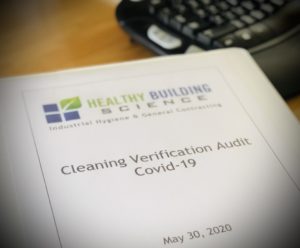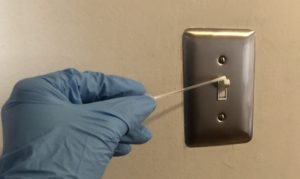Testing for Coronavirus – COVID-19 and Cleaning Audit
How to know your building is clean and safe.

Cleaning Verification Audit includes an inspection, testing, and cleaning protocol review.
Healthy Building Science now offers a Cleaning Verification Audit and Coronavirus testing to assess the effectiveness of cleaning related to Coronavirus (e.g., SARS-CoV-2). The goal of a cleaning audit is to verify, through a combination of visual inspection and surface testing, that cleaning procedures are being consistently practiced and that surface cleaning has been successful.
The Centers for Disease Control and Prevention (CDC) recommends that infection control procedures be implemented to help reduce the spread of COVID-19. These routine cleaning and disinfection procedures should be monitored to ensure that cleaning and disinfection procedures are followed consistently and correctly. For the purposes of this article “the virus” refers to SARS-CoV-2 virus that causes the disease COVID-19.
Our cleaning audit helps support hardworking facility maintenance and cleaning staff and can ensure that your cleaning protocol is current and effective. Verification may help reduce management liability and create confidence in the safety of your workplace environment.
Our cleaning audit includes a site-specific case history to better assess the business’s cleaning and COVID-19 awareness as a whole. To ensure alignment with CDC and Environmental Protection Agency (EPA) recommendations, we review the company’s cleaning protocol, employee training documentation, and documentation that disinfectants were allowed to remain wet on surfaces for the manufacturer’s recommended contact time. Product Safety Data Sheets (SDS) are also reviewed to protect occupants during and following application of a disinfectant and to make sure disinfectants are on the EPA Registered List N: Disinfectants for Use Against SARS-CoV-2. HBS can also help develop cleaning protocols and assist with deep cleaning contractor selection.
Our visual inspection provides detailed, on-the-ground scrutiny to help ensure cleaning activities were done correctly and can be corroborated with real-time surface sampling using a surrogate compound called ATP (Adenosine Triphosphate). In addition to assessment of cleaning protocols, a visual inspection is conducted to evaluate the efficacy of cleaning. During a site inspection, surface contamination can be visually evaluated and corroborated with sample swabs.

Testing for Coronavirus or COVID-19 on keyboards in office buildings and schools.
We have a cost-effective analysis “Coronavirus (CoV) Screen” that looks for SARS and MERS related coronavirus present on a surface but doesn’t differentiate between SARS-CoV, MERS-CoV or SARS-CoV-2 (COVID-19). This broader Coronavirus (CoV) screen for these coronaviruses is both cost-effective and useful because you don’t want any of them on an environmental surface post-cleaning.
A test offering “SARS-CoV-2 (COVID-19)” detection may be requested upfront while submitting the samples based on a client’s preference and can be used to specifically identify the presence or absence of SARS-CoV-2 RNA or can be requested as an add-on for samples that may have tested positive in an initial Coronavirus (CoV) screen.
Optionally the report may include a certificate stating, “On this date, this area passed third party verification for cleaning and disinfection as recommended by the CDC.” (It is important to note that at this time, a negative environmental testing result cannot exclude the presence of a virus within the setting where the investigation has been conducted.)
Biological Surface Testing for Coronavirus (CoV) & SARS-CoV-2 (COVID-19)
Surface sampling should be considered a key part of a quality assurance procedure to demonstrate that the building has been cleaned in accordance with recommended cleaning and disinfection procedures. Currently there are a few options for environmental testing to verify the effectiveness of cleaning related to SARS-CoV-2/COVID-19. To date this list includes: ATP, RT PCR, tape lifts and cultured mold or bacteria samples. There are significant pros and cons with each method and as the world scrambles to find ways to control the virus, all of these methods may prove to be helpful.

Coronavirus Swab Testing for ATP, SARS and COVID-19 analysis.
Here is a brief summary of each environmental testing method:
-
- ATP testing is a universally recognized tool for quickly measuring the hygiene levels of surfaces in order to ensure consistent sanitation practices as well as public safety. ATP (Adenosine Triphosphate) is an energy carrier found in all living organisms. For decades hospitals and food & beverage industries have used ATP testing to verify cleaning practices with instant, on location results. One drawback of this method is that it tests for the surrogate compound ATP, not the actual virus. Broadly speaking, the virus attaches to particles from living organisms, such as bacteria, fungi, and human cells, saliva, and feces. The general concept of ATP testing is that, if the biological matter has been removed then the levels of the virus have also been reduced.
- Tape Lifts Some hospitals and food & beverage industries cleaning protocols recommend collecting tape lifts in conjunction with ATP samples. Surface tape lifts samples are recommended to show that general environmental particulate matter has been removed at the microscopic level. Dander such as skin is counted under 400x magnification by light microscopy. ATP testing can give false negative results with certain disinfectants; when taken properly, surface debris samples examined by visual microscopy will not yield false negative results. Pros: Inexpensive, therefore larger surface areas can be sampled for a reasonable cost. Instant onsite readings. Cons: Does NOT specifically sample for the virus. Can yield false readings with some disinfectants.
- Fungal and bacteria culture sampling is another surrogate testing method. Swab samples are collected from cleaned surfaces and shipped to a lab to be grown in a petri dish for 4 days or longer. No bacterial colonies or mold growth detected in a surface sample indicates that there is a small likelihood that other microorganisms are present. Here is a link to more information about mold sampling services we offer. Pros: Inexpensive, therefore larger surface areas can be sampled for a reasonable price. Cons: Does NOT specifically sample for the virus, lengthy turnaround time over 4 days.
- RT PCR environmental testing follows the same principles as PCR medical testing currently in use. HBS is excited to offer this new service. RT PCR (Real-time polymerase chain reaction) seeks to match the surface sample with the virus’s unique genetic code. Swab samples are collected on high touch surfaces and then shipped overnight to the lab. Considered the “gold standard” for testing, it is the only method that specifically detects the virus causing the pandemic. For more information about the PCR method and medical testing for the virus in people, check the CDC website here.Pros: Specifically samples for the virus. Cons: More costly, may miss the virus as a smaller surface area can be sampled for a reduced budget, longer lab turnaround time of 3 days.
Scientists, industrial hygienists and policymakers are working together to understand the best way to test for the virus in our public spaces. At this time, we are utilizing all the surface sampling methods available, often in conjunction with another. An example of a robust testing schedule may involve 20-40 ATP samples to test for cleanliness plus RT PCR swabs to test for the actual virus.
All the components of our Cleaning Audit – documentation review, monitoring cleaning, a “white glove” visual inspection and surface sampling – work together to verify the effectiveness of your company’s enhanced cleaning related to COVID-19 HBS is ready to help make sure your cleaning procedure is robust and current. Whether you are looking for a one time inspection or on going monitoring, we can work together to build confidence and get your business running again.
Cleaning Effectiveness Sources and Recommended Reading
-
-
- The 2020 OSHA Guidance on Preparing Workplaces for COVID-19 has a helpful overview of workplace controls; Engineering Controls (HEPA air filters, increased ventilation, sneeze guards), Administrative Controls (encouraging sick workers to stay home, alternative office shifts, PPE training) and Safe Work Practices (provide hand sanitizer, tissue, no touch trash cans).
- OSHA (2020) Guidance on Preparing Workplaces for COVID-19. OSHA 3990-03 2020.
- IICRC/RIA (2020) Preliminary Report for Restoration Contractors Assisting Clients With COVID-19 Concerns – 19 March 2020. Institute of Inspection, Cleaning and Restoration Certificate / Restoration Industry Association.
- ATP as a Marker for Surface Contamination of Biological Origin in Schools and as a Potential Approach to the Measurement of Cleaning Effectiveness. Shaughnessy, R., Cole, G., Moschandreas, D. and U. Haverinen-Shaughnessy (2013) J. Occ. Env. Hygiene, 10:336-346.
- WHO (2020) Modes of Transmission of Virus Causing COVID-19: Implications for IPC Precaution Recommendations, 31 March 2020. Accessed at:
- Use of ATP Readings to Predict a Successful Hygiene Intervention in the Workplace to Reduce the Spread of Viruses on Fomites, Laura Y. Sifuentes, Food Environ Virol DOI 10.1007/s12560-016-9256-2
- Is the coronavirus airborne? Experts can’t agree. NEWS 02 APRIL 2020
-

Industrial hygienist using a microscope to evaluate cleaning efficacy during a Cleaning Verification Audit.
Coronavirus & COVID-19 Testing for San Francisco Bay Area
Healthy Building Science provides environmental testing services to multi-family buildings, single family homes, offices, industrial and manufacturing workplaces, hospitals and medical facilities in San Francisco, Alameda County, Contra Costa County, Marin County, Napa, San Mateo County, Santa Clara County, Solano County and Sonoma County.
We would be pleased to become your go-to environmental consultant and help you with any of your environmental lab testing or environmental survey needs.
To get a bid for cleaning verification audit or testing for Coronavirus, SARS-CoV-2, COVID-19, please call 415-785-7986 or complete this online form today!







